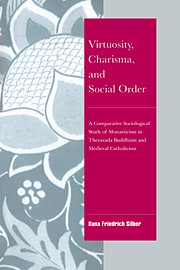 Virtuosity, Charisma and Social Order
Virtuosity, Charisma and Social Order Book contents
- Frontmatter
- Contents
- Preface
- Introduction
- Part I Virtuosi and society: elements of a comparative macrosociological approach
- Part II Virtuosi and society in Theravada Buddhism
- 3 Ideological groundings: hierarchy and ritualized exchange
- 4 Virtuosity institutionalized: the Sangha in social context
- 5 Virtuoso radicalism: the triumph of a sociological complex
- Part III Virtuosi and society in medieval Catholicism
- Part IV Virtuosity, charisma, and social order
- Conclusion: Religious virtuosity as ideological power: some implications for the comparative study of civilizations
- Bibliography
- Index
4 - Virtuosity institutionalized: the Sangha in social context
Published online by Cambridge University Press: 09 October 2009
- Frontmatter
- Contents
- Preface
- Introduction
- Part I Virtuosi and society: elements of a comparative macrosociological approach
- Part II Virtuosi and society in Theravada Buddhism
- 3 Ideological groundings: hierarchy and ritualized exchange
- 4 Virtuosity institutionalized: the Sangha in social context
- 5 Virtuoso radicalism: the triumph of a sociological complex
- Part III Virtuosi and society in medieval Catholicism
- Part IV Virtuosity, charisma, and social order
- Conclusion: Religious virtuosity as ideological power: some implications for the comparative study of civilizations
- Bibliography
- Index
Summary
The Sangha's organizational structures
Doctrinal Buddhism may seem to have originally addressed itself to the individual renouncer, emphatically enjoined to rely only on his own efforts in the pursuit of spiritual progress and salvation. The relentless emphasis on transcending family and property ties, on moving from home into homelessness and seeking refuge in none but oneself, “wandering along like the rhinoceros,” all seem to point toward an essentially individual, isolated, or even solitary way of life.
Nevertheless, the Buddha never advocated the practice of extreme solitude, and the idea of a Sangha, of a community of ascetics, appears to have been present from the very start, if at first only on a limited basis. The early followers of Gautama Buddha were supposedly enjoined to become wandering mendicants – not an uncommon vocation at the time. At least during the three-month rainy season, however, and following a practice common to other wandering sects as well, bhikkhus were supposed to retreat to a common residence. The development of a collective form of asceticism is often traced to this period of restricted mobility, favoring the intensification of communal life and the fulfillment of more lay-oriented duties. Be that as it may, the existence and corporate self-consciousness of a monastic order are already manifest in the Patimokka, probably the oldest layer in the Vinaya literature, stipulating various categories of offenses to a shared ascetic discipline.
- Type
- Chapter
- Information
- Virtuosity, Charisma and Social OrderA Comparative Sociological Study of Monasticism in Theravada Buddhism and Medieval Catholicism, pp. 80 - 104Publisher: Cambridge University PressPrint publication year: 1995
